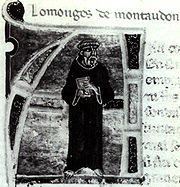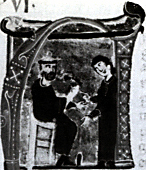
Monge de Montaudon
Encyclopedia

Floruit
Floruit , abbreviated fl. , is a Latin verb meaning "flourished", denoting the period of time during which something was active...
1193–1210), born Pèire de Vic, was a nobleman, monk
Monk
A monk is a person who practices religious asceticism, living either alone or with any number of monks, while always maintaining some degree of physical separation from those not sharing the same purpose...
, and troubadour
Troubadour
A troubadour was a composer and performer of Old Occitan lyric poetry during the High Middle Ages . Since the word "troubadour" is etymologically masculine, a female troubadour is usually called a trobairitz....
from the Auvergne
Auvergne (province)
Auvergne was a historic province in south central France. It was originally the feudal domain of the Counts of Auvergne. It is now the geographical and cultural area that corresponds to the former province....
, born at the castle of Vic-sur-Cère
Vic-sur-Cère
Vic-sur-Cère is a commune in the Cantal department in south-central France.-Population:...
near Aurillac
Aurillac
Aurillac is a commune in the Auvergne region in south-central France, capital of the Cantal department.Aurillac's inhabitants are called Aurillacois, and are also Cantaliens or Cantalous in Occitan....
, where he became a Benedictine
Benedictine
Benedictine refers to the spirituality and consecrated life in accordance with the Rule of St Benedict, written by Benedict of Nursia in the sixth century for the cenobitic communities he founded in central Italy. The most notable of these is Monte Cassino, the first monastery founded by Benedict...
monk around 1180. According to his vida
Vida (Occitan literary form)
Vida is the usual term for a brief prose biography, written in Old Occitan, of a troubadour or trobairitz.The word vida means "life" in Occitan languages. In the chansonniers, the manuscript collections of medieval troubadour poetry, the works of a particular author are often accompanied by a...
, he composed "couplets while he was in the monastery and sirventes
Sirventes
The sirventes or serventes is a genre of Occitan lyric poetry used by the troubadours. In early Catalan it became a sirventesch and was imported into that language in the fourteenth century, where it developed into a unique didactic/moralistic type...
on subjects that were popular in the region."
Life
The Monge requested and received the prioryPriory
A priory is a house of men or women under religious vows that is headed by a prior or prioress. Priories may be houses of mendicant friars or religious sisters , or monasteries of monks or nuns .The Benedictines and their offshoots , the Premonstratensians, and the...
of Montaudon from the abbot of Aurillac. Montaudon may be identified with Montauban
Montauban
Montauban is a commune in the Tarn-et-Garonne department in the Midi-Pyrénées region in southern France. It is the capital of the department and lies north of Toulouse....
or perhaps with a Mons Odonis southeast of Clermont
Clermont-Ferrand
Clermont-Ferrand is a city and commune of France, in the Auvergne region, with a population of 140,700 . Its metropolitan area had 409,558 inhabitants at the 1999 census. It is the prefecture of the Puy-de-Dôme department...
. He became so popular with local nobility that he was taken from his monastery to serve them, receiving honours and gifts in return. In this way he greatly improved the state of his priorate and, upon his request, was released from his monastic vocation by his abbot to follow Alfonso II of Aragon
Alfonso II of Aragon
Alfonso II or Alfons I ; Huesca, 1-25 March 1157 – 25 April 1196), called the Chaste or the Troubadour, was the King of Aragon and Count of Barcelona from 1164 until his death. He was the son of Ramon Berenguer IV of Barcelona and Petronilla of Aragon and the first King of Aragon who was...
, whose vassal the viscount of Carlat
Carlat
Carlat is a commune in the Cantal department in south-central France.The "Rocher de Carlat" or rock of Carlat situated above the picturesque commune was once the site of one of the most powerful and impenetrable chateaux in all of France. It was the seat of Jacques d'Armagnac, duke of Nemours, and...
and lord of Vic was. This is the view of his vida; he may have simply abandoned holy orders. Internal evidence in his poems suggests wide wanderings, to Périgord
Périgord
The Périgord is a former province of France, which corresponds roughly to the current Dordogne département, now forming the northern part of the Aquitaine région. It is divided into four regions, the Périgord Noir , the Périgord Blanc , the Périgord Vert and the Périgord Pourpre...
, Languedoc
Languedoc
Languedoc is a former province of France, now continued in the modern-day régions of Languedoc-Roussillon and Midi-Pyrénées in the south of France, and whose capital city was Toulouse, now in Midi-Pyrénées. It had an area of approximately 42,700 km² .-Geographical Extent:The traditional...
, and Catalonia
Catalonia
Catalonia is an autonomous community in northeastern Spain, with the official status of a "nationality" of Spain. Catalonia comprises four provinces: Barcelona, Girona, Lleida, and Tarragona. Its capital and largest city is Barcelona. Catalonia covers an area of 32,114 km² and has an...
, and the patronage of Dalfi d'Alvernha and Maria de Ventadorn
Maria de Ventadorn
Maria de Ventadorn was a patron of troubadour poetry at the end of the 12th century.Maria was one of las tres de Torena, "the three of Turenne", the three daughters of viscount Raymond II of Turenne and of Elise de Séverac. These three, according to Bertran de Born, possessed tota beltat terrena,...
.
At Alfonso's court, according to his vida, he ate meat, courted women, and composed songs and poems. In return he was appointed lord of the poetical society
Puy (society)
A puy or pui was a society, often organised as a guild or confraternity, sometimes along religious lines, for the patronisation of music and poetry, typically through the holding of competitions...
of Puy Sainta Maria (Puy-Sainte-Marie) at Le-Puy-en-Velay (Podium Aniciense) and received a sparrow hawk, the prize the society granted for superb poetry. According to his vida, he held the "suzerainty" of the "court of Puy" (cour du Puy) until it was dissolved.
After this he went to Roussillon
County of Roussillon
The County of Roussillon was one of the Catalan counties in the Marca Hispanica during the Middle Ages. The rulers of the county were the Counts of Roussillon, whose interests lay both north and south of the Pyrenees.-Visigothic county:...
, where he became prior of the Benedictine priory of Saint-Pierre-de-Belloc, near Villafranca
Villefranche-de-Conflent
Villefranche-de-Conflent is a commune in the Pyrénées-Orientales department in south of France.-The Capital of Conflent:The original town dates from 1098 and is fortified because of its strategic position in lands that changed hands between French and Spanish occupation.* 1374, Villefranche...
, though this establishment was not, contrary to his vida, a dependent of Aurillac. He is said to have "enriched [the priory] and improved it" before "ending his days" there.
Songs

Richard I of England
Richard I was King of England from 6 July 1189 until his death. He also ruled as Duke of Normandy, Duke of Aquitaine, Duke of Gascony, Lord of Cyprus, Count of Anjou, Count of Maine, Count of Nantes, and Overlord of Brittany at various times during the same period...
in Austria (1192–1194). Though seven of his cansos
Canso (song)
The canso is a song style used by the troubadours. It consists of three parts. The first stanza is the exordium, where the composer explains his purpose. The main body of the song occurs in the following stanzas, and usually draw out a variety of relationships with the exordium. The canso can end...
survive, he is most well known for the genres he probably invented: the enueg and plazer. He wrote four enuegz: Be m'enuejan, per saint Marsal and Be m'enueja, per saint Salvaire being two. His cansos are "rich in feudal metaphors".
Among the Monge's other works, Mout me platz deportz e gaieza and Be m'enueia, s'o auzes dire have been translated into English as "What I Like" and "What I Don't Like" respectively. He wrote fictional tenso
Tenso
A tenso is a style of Occitan song favoured by the troubadours. It takes the form of a debate in which each voice defends a position on a topic relating to love or ethics. Closely related genres include the partimen and the cobla exchange...
s with God
God
God is the English name given to a singular being in theistic and deistic religions who is either the sole deity in monotheism, or a single deity in polytheism....
. Around 1192–4 he wrote Pos Peire d'Alvernh' a chantat, a famous parody of a satire of Peire d'Alvernha. In it he insults his contemporaries, such as Arnaut Daniel
Arnaut Daniel
Arnaut Daniel de Riberac was an Occitan troubadour of the 12th century, praised by Dante as "il miglior fabbro" and called "Grand Master of Love" by Petrarch...
, Arnaut de Maruelh, Folquet de Marselha
Folquet de Marselha
Folquet de Marselha, alternatively Folquet de Marseille, Foulques de Toulouse, Fulk of Toulouse came from a Genoese merchant family who lived in Marseille...
, Gaucelm Faidit
Gaucelm Faidit
Gaucelm Faidit was a troubadour, born in Uzerche, in the Limousin, from a family of knights in service of the count of Turenne. He travelled widely in France, Spain, and Hungary...
, Guilhem Ademar
Guilhem Ademar
Guilhem Ademar was a troubadour from the Gévaudan. Noble by birth, but very poor, he travelled between the courts of Albi, Toulouse, Narbonne, and Spain. He achieved fame enough in his lifetime to be satirised by the Monge de Montaudon. He entered holy orders towards the end of his life...
, Guillem de Saint Didier, Peire Vidal
Peire Vidal
Peire Vidal was a troubadour. According to his biography, he was born in Toulouse, the son of a furrier, and the greatest of singers....
, Peirol
Peirol
Peirol or PeiròlIn Occitan, peir means "stone" and -ol is a diminutive suffix, the name Peirol being understood as the equivalent of "Little Stone" but also "Petit Pierre" or "Pierrot" ; however, "peiròl" also meant a cauldron or a stove...
, Raimon Jordan
Raimon Jordan
Raimon Jordan was a Toulousain troubadour and the viscount of Saint-Antonin in the Rouergue near the boundary with Quercy ....
, and Raimon de Miraval
Raimon de Miraval
Raimon de Miraval was a troubadour and, according to his vida, "a poor knight from Carcassonne who owned less than a quarter of the castle of Miraval." Favoured by Raymond VI of Toulouse, he was also later associated with Peter II of Aragon and Alfonso VIII of Castile...
. Two of his melodies survive. One of these, the music for the enueg Fort m'enoja, so auzes dire was borrowed from a sirventes, Rassa, tan creis e mont, of Bertran de Born
Bertran de Born
Bertran de Born was a baron from the Limousin in France, and one of the major Occitan troubadours of the twelfth century.-Life and works:...
: the only piece of Bertran's music to survive. Only one melody by the Monge himself—for a canso entitled Ara pot ma dona saber—survives. Nonetheless, this lone piece of work is characterised by phrase variation and motivic transformation, with an unexpected ending.
The poem S'eu vos voill tan gen lauzar was appended to a set of four by the Monge in the 13th century, but it is probably a work of Jausbert de Puycibot
Jausbert de Puycibot
Jausbert de Puycibot or Gausbert de Poicibot or Puicibot, sometimes called Lo Monge de Poicibot and elsewhere Audebert, was a Limousin troubadour of the early thirteenth century...
.

